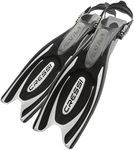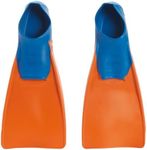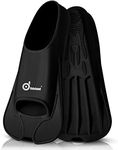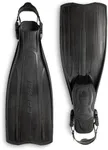Buying Guide for the Best Scuba Fins
Choosing the right scuba fins is crucial for an enjoyable and efficient diving experience. The right pair of fins can help you move through the water with ease, conserve energy, and enhance your overall diving performance. When selecting scuba fins, consider factors such as the type of diving you'll be doing, your physical condition, and your personal preferences. Here are some key specifications to consider when choosing scuba fins and how to navigate them to find the best fit for you.Fin TypeThere are two main types of scuba fins: open-heel and full-foot. Open-heel fins are designed to be worn with neoprene boots and are adjustable, making them suitable for cold water diving and providing a secure fit. Full-foot fins are worn barefoot and are typically used in warm water. They are lighter and more streamlined but offer less protection. Choose open-heel fins if you plan to dive in various water temperatures or need extra foot protection. Opt for full-foot fins for warm water diving and if you prefer a lighter, more compact fin.
Blade DesignBlade design affects the fin's performance and efficiency. Traditional paddle blades provide a good balance of power and maneuverability, making them suitable for most divers. Split fins have a split down the middle, reducing resistance and making them easier to kick, which can be beneficial for divers with less leg strength or those who want to conserve energy. Channel fins have grooves that channel water for more efficient propulsion. Choose paddle blades for versatility, split fins for ease of use and energy conservation, and channel fins for enhanced propulsion.
MaterialScuba fins are typically made from rubber, plastic, or a combination of both. Rubber fins are durable and provide good flexibility, but they can be heavier. Plastic fins are lighter and often more affordable but may not be as durable. Composite fins combine the best of both materials, offering a balance of durability, flexibility, and weight. Consider rubber fins for durability and flexibility, plastic fins for lightweight and affordability, and composite fins for a balanced performance.
Length and StiffnessThe length and stiffness of the fin blade affect your kicking power and control. Longer fins provide more thrust but require more leg strength, making them suitable for strong swimmers and those diving in strong currents. Shorter fins are easier to maneuver and require less effort, ideal for beginners or those diving in calm waters. Stiffer fins offer more power but can be tiring, while softer fins are easier to kick but provide less propulsion. Choose longer, stiffer fins for strong currents and experienced divers, and shorter, softer fins for calm waters and beginners.
Foot PocketThe foot pocket is where your foot fits into the fin. A well-fitting foot pocket is essential for comfort and efficiency. Open-heel fins have adjustable straps, allowing for a customizable fit and the ability to wear boots. Full-foot fins have a fixed foot pocket, so it's important to find the right size for a snug fit without being too tight. Ensure the foot pocket is comfortable and secure, as an ill-fitting pocket can cause discomfort and reduce your diving efficiency. Try on different sizes and styles to find the best fit for your foot shape and size.










![Cressi Agua (Pink) [37/38]](https://images-proxy.bestreviews.guide/eNfvPaUxjvpVv392rJePNbeP4M0=/0x150/https://m.media-amazon.com/images/I/41uAmh1H6HL._AC_CX679_.jpg)









